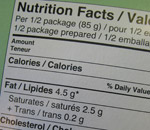 Nutritional science and food marketing has become so sophisticated in recent decades that a trip to the supermarket can require a complete nutritional re-education. The average consumer needs to be on guard against preservatives, added fat, colorings, and calories, false advertising, and sophisticated but misleading labels. Although guidelines for the information of food labels have gotten a bad rap in recent years a new study published in the Journal of Consumer Affairs suggests that observing them may lead to weight loss, especially for women entering their middle years.
Nutritional science and food marketing has become so sophisticated in recent decades that a trip to the supermarket can require a complete nutritional re-education. The average consumer needs to be on guard against preservatives, added fat, colorings, and calories, false advertising, and sophisticated but misleading labels. Although guidelines for the information of food labels have gotten a bad rap in recent years a new study published in the Journal of Consumer Affairs suggests that observing them may lead to weight loss, especially for women entering their middle years.
Using information on whether consumers read food labels the first time they buy a product, the research finds that people who observe the labels and do not exercise display a slightly greater likelihood of weight loss than those who do exercise but do not pay attention to food labels. By simply adding an exercise routine to their lifestyle regular food label readers can increase their changes of losing weight. Women between the ages of 37-50 years are more likely to read food labels than men, and are therefore more likely to lose weight.”
Previous research has focused on food marketing and behavior but has not followed related weight loss over time in this middle-aged demographic group. The data for this study was taken from a National Longitudinal Survey of Youth compiled from 2002-2006. The survey began in 1979 with over 12,000 male and female participants born in the years 1957-1964.
Over fifty percent of participants reported that they were trying to lose or control weight. Of these participants, almost seventy percent were obese or overweight. Almost fifty percent were actively reading food labels on their first time purchase and slightly more than twenty-five percent were actively participating in vigorous exercise. Overall, older individuals are less likely to lose weight by reading food labels, and general participation in vigorous exercise drops off after age forty-five.
Additionally, the Nutrition Labeling and Education Act (NLEA), enacted in 1994, requires all food manufactures to present essential nutrient and ingredient information on food packages. According to the recently-passed health care reform bill there will be easier access to nutritional information at restaurants, retail food establishments, and vending machines. Combined with these new findings, it is likely that this measure will be useful to those who want to lose weight and read food labels to make well-informed decision regarding their diets in and outside their homes.
Weight loss programs and plans would do well in augmenting their client’s weight loss goals with the recommended use of food labels, in order to maintain a healthy weight. This is particularly important as people enter middle age and are at a risk for heart disease, obesity-related diabetes, cancer and dementia.
Material adapted from Wiley-Blackwell.
Reference
“Use of Food Labels as a Weight Loss Behavior.” Bidisha Mandal. Journal of Consumer Affairs; Published Online: September 8, 2010 (DOI: 10.1111/j.1745-6606.2010.01181.x)
No comments yet.